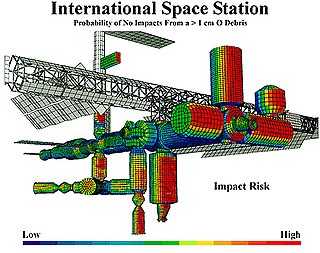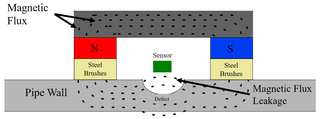
Safety engineering is an engineering discipline which assures that engineered systems provide acceptable levels of safety. It is strongly related to industrial engineering/systems engineering, and the subset system safety engineering. Safety engineering assures that a life-critical system behaves as needed, even when components fail.

Within industry, piping is a system of pipes used to convey fluids from one location to another. The engineering discipline of piping design studies the efficient transport of fluid.
Failure mode and effects analysis is the process of reviewing as many components, assemblies, and subsystems as possible to identify potential failure modes in a system and their causes and effects. For each component, the failure modes and their resulting effects on the rest of the system are recorded in a specific FMEA worksheet. There are numerous variations of such worksheets. An FMEA can be a qualitative analysis, but may be put on a quantitative basis when mathematical failure rate models are combined with a statistical failure mode ratio database. It was one of the first highly structured, systematic techniques for failure analysis. It was developed by reliability engineers in the late 1950s to study problems that might arise from malfunctions of military systems. An FMEA is often the first step of a system reliability study.
Failure causes are defects in design, process, quality, or part application, which are the underlying cause of a failure or which initiate a process which leads to failure. Where failure depends on the user of the product or process, then human error must be considered.
Reliability engineering is a sub-discipline of systems engineering that emphasizes the ability of equipment to function without failure. Reliability describes the ability of a system or component to function under stated conditions for a specified period of time. Reliability is closely related to availability, which is typically described as the ability of a component or system to function at a specified moment or interval of time.

Fouling is the accumulation of unwanted material on solid surfaces. The fouling materials can consist of either living organisms (biofouling) or a non-living substance. Fouling is usually distinguished from other surface-growth phenomena in that it occurs on a surface of a component, system, or plant performing a defined and useful function and that the fouling process impedes or interferes with this function.
Structural health monitoring (SHM) involves the observation and analysis of a system over time using periodically sampled response measurements to monitor changes to the material and geometric properties of engineering structures such as bridges and buildings.

Magnetic flux leakage is a magnetic method of nondestructive testing that is used to detect corrosion and pitting in steel structures, most commonly pipelines and storage tanks. The basic principle is that a powerful magnet is used to magnetize the steel. At areas where there is corrosion or missing metal, the magnetic field "leaks" from the steel. In an MFL tool, a magnetic detector is placed between the poles of the magnet to detect the leakage field. Analysts interpret the chart recording of the leakage field to identify damaged areas and to estimate the depth of metal loss.
Risk Based Inspection (RBI) is an Optimal maintenance business process used to examine equipment such as pressure vessels, (QOC) quick opening closure - doors, heat exchangers, and piping in industrial plants. RBI is a decision-making methodology for optimizing inspection plans. The RBI concept lies in that the risk of failure can be assessed in relation to a level that is acceptable, and inspection and repair used to ensure that the level of risk is below that acceptance limit. It examines the Health, Safety and Environment (HSE) and business risk of ‘active’ and ‘potential’ Damage Mechanisms (DMs) to assess and rank failure probability and consequence. This ranking is used to optimize inspection intervals based on site-acceptable risk levels and operating limits, while mitigating risks as appropriate. RBI analysis can be qualitative, quantitative or semi-quantitative in nature.
Mandatory Integrity Control (MIC) is a core security feature of Windows Vista and later that adds mandatory access control running processes based on their Integrity Level (IL). The IL represents the level of trustworthiness of an object. This mechanism's goal is to restrict the access permissions for potentially less trustworthy contexts, compared with other contexts running under the same user account that are more trusted.
Corrosion engineering is an engineering specialty that applies scientific, technical, engineering skills, and knowledge of natural laws and physical resources to design and implement materials, structures, devices, systems, and procedures to manage corrosion. From a holistic perspective, corrosion is the phenomenon of metals returning to the state they are found in nature. The driving force that causes metals to corrode is a consequence of their temporary existence in metallic form. To produce metals starting from naturally occurring minerals and ores, it is necessary to provide a certain amount of energy, e.g. Iron ore in a blast furnace. It is therefore thermodynamically inevitable that these metals when exposed to various environments would revert to their state found in nature. Corrosion and corrosion engineering thus involves a study of chemical kinetics, thermodynamics, electrochemistry and Materials science.
Pipeline leak detection is used to determine if and in some cases where a leak has occurred in systems which contain liquids and gases. Methods of detection include hydrostatic testing, infrared, and laser technology after pipeline erection and leak detection during service.
Technical Integrity Engineering is a term applied to the engineering disciplines associated with the design, assurance, and verification functions that ensure a product, process, or system meets its appropriate and intended requirements under stated operating conditions. Application of these disciplines minimizes the cost, schedule, technical, and legal risks of a program and improves the overall life cycle cost.
An Integrity Engineering Audit is carried out within an Integrity engineering function so as to ensure compliance with international, national and company specific standards and regulations.
The ASME Boiler & Pressure Vessel Code (BPVC) is an American Society of Mechanical Engineers (ASME) standard that regulates the design and construction of boilers and pressure vessels. The document is written and maintained by volunteers chosen for their technical expertise. The ASME works as an accreditation body and entitles independent third parties to inspect and ensure compliance to the BPVC.
Integrity Management Plan is a documented and systematic approach to ensure the long-term integrity of an asset or assets.
Corrosion loop(s) are systematized analysis "loops" used during Risk-based inspection analysis. Both terms “RBI Corrosion loops” or “RBI corrosion circuits” are generic terms used to indicate the systematization of piping systems into usable and understandable parts associated with corrosion. Systematized piping loops or circuits are systems used in Risk Based Inspection analysis to assess the likelihood and consequence of failure. Other systematization may also prove useful, such as, i.e. inspection, consequence, materials of construction and chemistry. The system maybe used to identify, pressure / temperature, subsequent failure mechanism and possible failure rate. They may be based upon Construction drawings, Process Flow diagrams or Piping & Instrument diagrams as required. Each loop or circuit maybe identified using a unique code, with description about; process, material & degradation mode, material, cladding, C.A, specs. See system model comes under the general heading of system analysis the terms analysis and synthesis come from Greek where they mean respectively "to take apart" and "to put together". See also systems theory: Note the exact definition of the systematized risk analysis " loop" is left to the reader and their requirements of the system analysis required, however to ensure consistency and that the expected results is produced, this should be defined before they are constructed. It is suggested that a “true” corrosion loop should be a grouping were the degradation mechanism is "likely" to be the same i.e.
Metal profile sheet systems are used to build cost efficient and reliable envelopes of mostly commercial buildings. They have evolved from the single skin metal cladding often associated with agricultural buildings to multi-layer systems for industrial and leisure application. As with most construction components, the ability of the cladding to satisfy its functional requirements is dependent on its correct specification and installation. Also important is its interaction with other elements of the building envelope and structure. Metal profile sheets are metal structural members that due to the fact they can have different profiles, with different heights and different thickness, engineers and architects can use them for a variety of buildings, from a simple industrial building to a high demand design building. Trapezoidal profiles are large metal structural members, which, thanks to the profiling and thickness, retain their high load bearing capability. They have been developed from the corrugated profile. The profile programme offered by specific manufacturers covers a total of approximately 60 profile shapes with different heights. Cassettes are components that are mainly used as the inner shell in dual-shell wall constructions. They are mainly used in walls today, even though they were originally designed for use in roofs.
Robotic non-destructive testing (NDT) is a method of inspection used to assess the structural integrity of petroleum, natural gas, and water installations. Crawler-based robotic tools are commonly used for in-line inspection (ILI) applications in pipelines that cannot be inspected using traditional intelligent pigging tools.
Post weld heat treatment (PWHT) is a controlled process in which a material that has been welded is reheated to a temperature below its lower critical transformation temperature, and then it is held at that temperature for a specified amount of time. It is often referred to as being any heat treatment performed after welding; however, within the oil, gas, petrochemical and nuclear industries, it has a specific meaning. Industry codes, such as the ASME Pressure Vessel and Piping Codes, often require mandatory performance of PWHT on certain materials to ensure a safe design with optimal mechanical and metallurgical properties.



